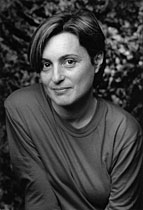She was born in Avellaneda, Buenos Aires Province, in 1951. She studied at the Escuela Nacional de Cerámica. She took painting classes with Renato Benedetti, drawing classes with Miguel Angel Bengochea and sculpture classes with Emilio Renart. Her first public appearances go back to 1983 when she took part in a group exhibition at Estudio Giesso and a short time later she presented her first solo exhibition at El Porteño, magazine. The following year, she participated in Kriptonita verde, prepared by the Museo Juan Carlos Castagnino in Mar del Plata. Being somewhat unconventional in temperament, she chose atypical spaces for her works. In 1985, she "unfurled" Una bufanda para la ciudad de Buenos Aires (A scarf for the city of Buenos Aires), a work she displayed in Florida Street. That same year, she organised a group show entitled Lavarte (wash yourself) in an automatic laundrette in Bartolomé Mitre Street. Following this line of action, she exhibited Ouróboros, an object made up of unbound books forming the mythical serpent that devours itself, at the Facultad de Filosofía y Letras during 1991. These events related her to the neo-dadaism of the '60s, when art, leaving the temples that were dedicated to it, burst into everyday life with its happenings.
That attraction to turning away from the norm continued when she made small geometric forms of bronze, contained in a wooden box, inviting the observer to think about stripping things down to their barest expression. This, and a series of similar works, formed No todo lo que brilla es oro (All that glistens is not gold), an exhibition she held at the Galería Adriana Indik in 1989. The same thing happened when she used constructions of this type, in this case of large proportions, for Ecuación-El Dorado (El Dorado Equation) installation presented at La Conquista exhibition at Centro Cultural Recoleta in 1991. A golden sphere and cube supported on a red lacquered truncated pyramid were used to express aspects of the conquest of America. The sphere and cube represent the gold extracted by the Spaniards; supported on the other component of the equation, an ingot of spilled indigenous blood as tribute to the sacking of the native Indians. A colonial style throne as an emblem of power and a computer providing data on the indigenous population update and simultaneously distort a tendency which, just as minimalism, would never accept being a support for any metaphor whatsoever. Both Kermesse. El paraíso de las bestias (The paradise of the beasts) exhibition (Centro Cultural Recoleta, 1986) and La Conquista (The Conquest) were multidisciplinary events organised by Maresca, and they involved many artists who combined their works in a common project.
With Lo que el viento se llevó (Gone with the wind), installation carried out in 1989, the activities at the art gallery of the Centro Cultural Rector Ricardo Rojas (UBA) were inaugurated. The show included demolished skeletons of garden furniture that lyrically display the melancholia caused by the awareness existence.
Recolecta (Centro Cultural Recoleta, 1990) was an installation whose centrepiece was a scrap-dealer's cart taken from reality, that she used to indicate social marginalisation and anticipates, with the certainty of art, a frightful problem that would occur ten years later. Nevertheless, the transmutation of the cart, reflected in other components of the work, as in a white monument or small replicas in gold and silver, surpasses a mere denunciation. It is here that the art exhibits its power of transfiguration that in many cases Maresca represents with ritual or alchemist operations.
Shortly afterwards, abandoning any aesthetic content, she made the symbolic possibilities of artistic expression more evident. In the installation titled Espacio disponible (Available space) (Centro Cultural Recoleta, 1992), street advertising posters provided concise information on her availability and her telephone number. The erotic photographs that were taken of her in 1993 for the magazine El libertino, appeared under the title Maresca se entrega a todo destino (Maresca goes for anything), have a similar purpose and connect photo performance with the notion of the multiple forms of the media.
During that year, she carried out another aesthetic operation in which the graphic communication media no longer act as a support but as the very reason. In Imagen pública - Altas esferas (Public Image - High Spheres) she used the graphic archive of the daily paper Página 12. Enlarged photographs of the protagonists of the Argentine news of the past decade were used to adorn the walls and ceiling of a exhibition hall at the Centro Cultural Recoleta which was covered by these giant photographs. In the centre of the room was a sort of stepped altar on top of which was an earthen bowl catching the incessant dripping of a red liquid. This was a metaphor for the strange mixture of ink and blood that in our mediatic society composes the body of the news and which became a tribute to those faces that acquired their notoriety thanks to the vicissitudes of the citizens' lives. The critical tone becomes sarcasm when Maresca imposes on these photographs the image of her naked body on the postcards and poster-catalogues that accompanied the exhibition.
She died in Buenos Aires in 1994 without being able to attend the inauguration of Frenesí (Frenzy), a retrospective exhibition of her work held at Centro Cultural Recoleta.
